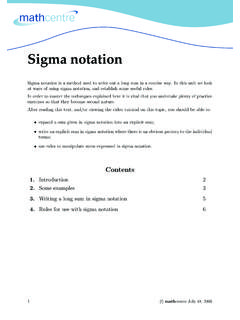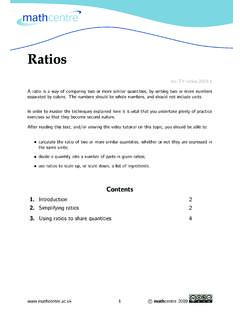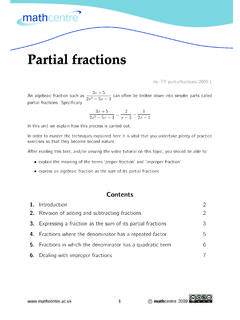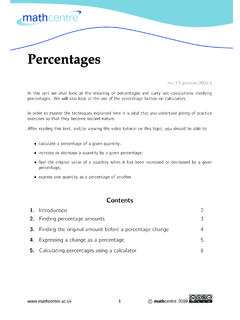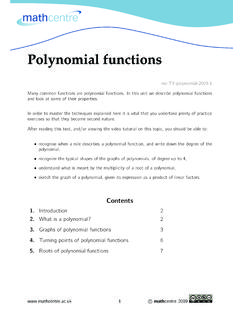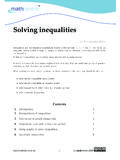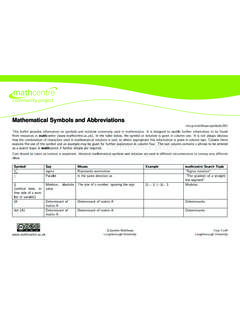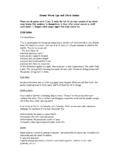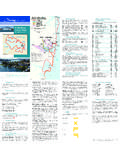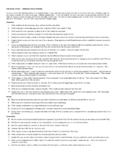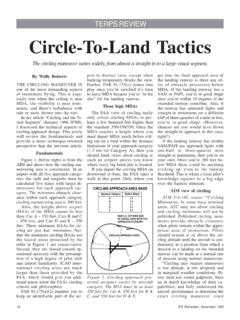Transcription of The geometry of a circle - mathcentre.ac.uk
1 The geometry of a circle mc-TY-circles-2009-1. In this unit we find the equation of a circle , when we are told its centre and its radius. There are two different forms of the equation, and you should be able to recognise both of them. We also look at some problems involving tangents to circles. In order to master the techniques explained here it is vital that you undertake plenty of practice exercises so that they become second nature. After reading this text, and/or viewing the video tutorial on this topic, you should be able to: find the equation of a circle , given its centre and radius;. find the centre and radius of a circle , given its equation in standard form;. find the equation of the tangent to a circle through a given point on its circumference;. decide whether a given line is tangent to a given circle . Contents 1. Introduction 2. 2. The equation of a circle centred at the origin 2. 3.
2 The general equation of a circle 4. 4. The equation of a tangent to a circle at a given point 7. 1 c mathcentre 2009. 1. Introduction The circle is a familiar shape and it has a host of geometric properties that can be proved using the traditional Euclidean format. But it is sometimes useful to work in co-ordinates and this requires us to know the standard equation of a circle , how to interpret that equation and how to find the equation of a tangent to a circle . This video will explore these particular facets of a circle , using co-ordinate geometry . 2. The equation of a circle centred at the origin The simplest case is that of a circle whose centre is at the origin. Let us take an example. What will be the equation centred on the origin with radius 5 units? 5. P(x, y). 5. y x 5 O N 5. 5. If we take any point P (x, y) on the circle , then OP = 5 is the radius of the circle . But OP is also the hypotenuse of the right-angled triangle OP N, formed when we drop a perpendicular from P.
3 To the x-axis. Now in the right-angled triangle, ON = x and NP = y. Thus, using the theorem of Pythagoras, x2 + y 2 = 52 = 25 . And this equation is true for any point on the circle . For instance, we could take a point Q(x1 , y1 ). in a different quadrant. 5. Q(x1, y 1). 5. y1. x1. 5 N O 5. 5. Once again, we can drop a perpendicular from Q to the x-axis. And now we can use the right- angled triangle OQN to see that x21 + y12 = 52 . So the co-ordinates (x1 , y1 ) of the point Q also satisfy the equation x2 + y 2 = 25. 2 c mathcentre 2009. We shall now take the radius of the circle to be r. r P(x, y). r y x r O N r r If we take any point P (x, y) on the circle , then OP = r is the radius of the circle . But OP is also the hypotenuse of the right-angled triangle OP N, formed when we drop a perpendicular from P. to the x-axis. In the right-angled triangle, ON = x and NP = y. Thus, using the theorem of Pythagoras, x2 + y 2 = r 2 , and this is the equation of a circle of radius r whose centre is the origin O(0, 0).
4 Key Point The equation of a circle of radius r and centre the origin is x2 + y 2 = r 2 . 3 c mathcentre 2009. 3. The general equation of a circle What is the equation of a circle of radius r, centred at the point C(a, b)? P(x, y). r y b C(a, b). N. O x a We shall take a horizontal line through the centre C and drop a perpendicular from P to meet this horizontal line at N. Then again we have a right-angled triangle CP N, where CP = r is the hypotenuse, and where we have CN = x a and P N = y b. Thus using Pythagoras again we have CN 2 + P N 2 = CP 2 , so that (x a)2 + (y b)2 = r 2 . Expanding the brackets gives x2 2ax + a2 + y 2 2by + b2 = r 2 , and if we bring r 2 to the left-hand side and rearrange we get x2 2ax + y 2 2by + a2 + b2 r 2 = 0 . It is a convention, at this point, to replace a by g and b by f . This gives x2 + 2gx + y 2 + 2f y + g 2 + f 2 r 2 = 0 . Now look at the last three terms on the left-hand side, g 2 + f 2 r 2.
5 These do not involve x or y at all, so together they just represent a single number that we can call c. Substituting this into the equation finally gives us x2 + 2gx + y 2 + 2f y + c = 0 . This is the general equation of a circle . We can recognise it, because it is quadratic in both x and y, and it has two additional properties. First, there is no term in xy. And secondly, the coefficient of x2 is the same as the coefficient of y 2. (In fact, our equation has both coefficients equal to 1, but you can always multiply an equation by a non-zero constant to obtain another valid equation, and so we must allow for this possibility.) The centre of the circle is then at (a, b) = ( g, f ) and, since c = g 2 + f 2 r 2 , we have r2 = g 2 + f 2 c , so that the radius of the circle is given by p r= g2 + f 2 c . 4 c mathcentre 2009. Key Point The general equation of a circle is x2 + y 2 + 2gx + 2f y + c = 0 , p where the centre is given by ( g, f ) and the radius by r = g 2 + f 2 c.
6 The equation can be recognised because it is given by a quadratic expression in both x and y with no xy term, and where the coefficients of x2 and y 2 are equal. Example Find the centre and radius of the circle x2 + y 2 6x + 4y 12 = 0 . Solution First, we can check that the expression on the left-hand side is quadratic, that there is no term involving xy, and that the coefficients of x2 and y 2 are equal. So this is the equation of a circle . If we compare this equation with the standard equation x2 + y 2 + 2gx + 2f y + c = 0 , we see that g = 3 and f = 2, so that the centre is ( g, f ) = (3, 2). We also see that c = 12, so we can find the radius by calculating p r = g2 + f 2 c p = ( 3)2 + 22 ( 12).. = 9 + 4 + 12.. = 25. = 5. An alternative method is to attempt to reconstruct the equation of the circle in the form (x a)2 + (y b)2 = r 2. by completing the square. We start by collecting together the terms in x, and the terms in y.
7 So we rewrite our equation x2 + y 2 6x + 4y 12 = 0. as x2 6x + y 2 + 4y 12 = 0 . Now the terms in x must come from (x a)2 , a complete square, so we complete the square for the x terms, and similarly for the y terms, to get (x 3)2 9 + (y + 2)2 4 12 = 0 . 5 c mathcentre 2009. So we have (x 3)2 + (y + 2)2 25 = 0 , which we rewrite as (x 3)2 + (y + 2)2 = 25 = 52 . We can now see that the centre of the circle is (3, 2) and the radius is 5. Example Find the centre and radius of the circle 2x2 + 2y 2 8x 7y = 0 . Solution Notice that this is the equation of a circle , even though the coefficients of x2 and of y 2 are not equal to 1. But we can divide throughout by 2, and we get x2 + y 2 4x 72 y = 0 . If we compare this with the standard equation x2 + y 2 + 2gx + 2f y + c = 0. we see that g = 2 and f = 74 , so the centre of the circle is ( g, f ) = (2, 74 ). We also see that c = 0, so we find the radius by calculating p r = g2 + f 2 c q 2.
8 = ( 2)2 + 47. q 49. = 4 + 16. q 113. = 16. 1.. = 4 113 . Alternatively, we could try completing the square to regain the form (x a)2 + (y b)2 = r 2 . So we start with our equation 2x2 + 2y 2 8x 7y = 0 , and again we divide by 2 to get x2 + y 2 4x 72 y = 0 . Collecting the x terms together and the y terms together, we get x2 4x + y 2 27 y = 0 , and then completing the square gives us 7 2. (x 2)2 4 + y . 49. 4. 16. =0. so that 7 2. (x 2)2 + y . 113. 4. = 16.. We can now see that the centre of the circle is (2, 74 ) and the radius is 1. 4. 113. 6 c mathcentre 2009. Example Find the centre and radius of the circle x2 + y 2 + 8x + 7 = 0 . Solution Notice that, in this example, there is no y term. If we compare our equation with the standard equation x2 + y 2 + 2gx + 2f y + c = 0 , we see that g = 4 and f = 0. So the centre of the circle is ( g, f ) = ( 4, 0). We also see that c = 7, so we find the radius by calculating p r = g2 + f 2 c.
9 = 42 + 02 7.. = 16 7.. = 9. = 3. Exercises 1. Find the equation of the circle with given centre and radius: (a) centre (3, 5), radius 3; (b) centre ( 2, 3), radius 1; (c) centre ( 1, 3), radius 2;. (d) centre (2, 2), radius 5; (e) centre (0, 5) radius 4. 2. Identify the centre and radius of the following circles: (a) x2 + y 2 2x 4y 20 = 0, (b) x2 + y 2 4x + 6y + 4 = 0, (c) x2 + y 2 + 2x 3 = 0, (d) x2 + y 2 + 6x + 7y 14 34 = 0, (e) 3x2 + 3y 2 6x + 9y + 5 = 0. 4. The equation of a tangent to a circle at a given point What is the equation of the tangent to the circle x2 + y 2 + 2x + 4y 3 = 0 at the point (1, 4). on the circle ? For a question like this, we should check first that the given point does indeed lie on the circle . If we substitute x = 1 and y = 4 into the equation, we obtain 12 + ( 4)2 + 2 1 + 4 ( 4) 3 = 1 + 16 + 2 + ( 16) 3 = 0 , and so the equation is satisfied. In fact we can see this from a diagram.
10 Tangent ( 1, 2). (1, 4). 7 c mathcentre 2009. We have also marked the centre of the circle on the diagram. To find the centre, we note that g = 1 and f = 2, so that the centre is at ( 1, 2). A tangent is a straight line that just touches the circle . To find the equation of a straight line, we need to know either two points on it, or one point on it together with its gradient. In this example, we know one point on the line, the point (1, 4) where it is to touch the circle . But we do not know another point. Nor do we know the gradient. So what should we do? One fact we do know is that the tangent to a circle is perpendicular to the radius at the point of contact. In this case, we know the point of contact (1, 4), and we also know the centre ( 1, 2). We can therefore calculate the gradient of the radius from the centre to the point of contact, and hence the gradient of the tangent. Now the gradient m of a straight line joining the points (x1 , y1 ) and (x2 , y2 ) is given by y2 y1.
